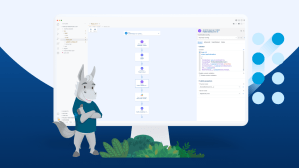Editor’s Note: Salesforce Genie is now Salesforce Data Cloud. For the latest on Data Cloud, go here.
Key Takeaways
- Quick take: Salesforce President & Chief Product Officer David Schmaier is a software industry pioneer with deep roots in the CRM space. In this article, he shares how customer data platforms have evolved over time and how Salesforce Data Cloud, a new data platform powering the world’s first real-time CRM, will shape the future.
For the last 30 years, I’ve been fortunate to work with amazing teams on the front lines of enterprise software, building products in pursuit of what many call the Holy Grail of CRM.
It’s not a chalice imbued with miraculous powers to increase sales — it’s a hyperscale customer data platform (CDP) that connects every relevant bit of historical and real-time data to create a single, golden record for every customer, providing the ingredients required to drive customer experiences across every channel that genuinely feel like magic.
At times attaining this Holy Grail seemed unachievable. Along this journey, many of us on this quest have felt like Indiana Jones, faced with various obstacles and setbacks at the forefront of CRM’s evolution — though luckily, without the snakes.
I remember a marketing class on the first day of graduate business school where the professor asked over and over again, ‘Who’s the customer?’ This was drilled into my mind — you need to know who the customer is before you upsell, cross sell, or provide personalized service and tailored marketing campaigns. And, you can’t know your customer if you don’t have all the relevant data and a single source of truth.
And, you can’t know your customer if you don’t have all the relevant data and a single source of truth.
But if all you have are disconnected bits of data about a customer — scattered points of light that are required to illuminate their needs and wants — you really don’t know your customer.
That’s how it was when I began my career in the CRM industry in the 1990s. In 1994, when I joined Siebel Systems, the CRM industry was still in its infancy, with leading analysts reporting annual worldwide CRM software sales at $50 million in revenue. Companies at the time built their own custom database software for managing contacts, sales leads, or service cases. Data was siloed and APIs and other data management services that made it easier to integrate data weren’t prevalent. There was no single source of customer truth and these home-grown salesforce automation (SFA) and customer service solutions were costly and ineffective.
Early pioneering companies like Siebel, and later, larger established software companies like Oracle and SAP, invested in building packaged CRM solutions starting with SFA. Then, they added customer service, marketing, and other business functions and industry-specific solutions. In 1999, a fledgling Salesforce came on the scene with a new technology platform based in the cloud and a subscription business model. It was the beginning of a revolution led by Salesforce that transformed CRM into a $60 billion software industry today.
I had worked with Marc Benioff at Oracle in the 1980s, and was impressed by how he and his team were able to create a platform as a service and ecosystem for CRM that far exceeded what was previously considered possible. I was pulled into the Salesforce orbit in 2014 when I co-founded Vlocity, an ISV which built industry-specific clouds for communications, media and entertainment, energy and utilities, insurance, health, and public sector organizations built entirely on the Salesforce platform. And in 2020 Salesforce acquired Vlocity — and our talented Vlocity team — and I officially became part of the Salesforce family.
Over the last 30 years, advances in processing power, storage capacity, internet connectivity, artificial intelligence, and other technologies propelled the entire software industry forward. Data integration through APIs, data lakes, and other data management systems became less cumbersome. But the customer data problem continued to persist.
Disconnected data leads to fragmented and costly customer experiences
Today, larger enterprises have an average of 976 different applications to run their business — that’s 976 potential versions of a single customer and 976 records about each and every customer. Instead of a unified, 360-degree view of the customer, you have fragmented glimpses and disconnected, disjointed experiences.
For example, when you call your phone company to change your mobile plan, you have to give them your personal information. If you get transferred to another department, you then have to give all the same information — again. And the rep doesn’t have access to real-time information — they don’t know that you just tried to change your mobile plan on their website, just paid your bill online, or that seconds ago you activated a new mobile phone. Not to mention that every additional second you remain on the phone costs the company more money and further downgrades their “net promoter score” that measures customer satisfaction. Companies tend to think “products out” rather than “customer in” — and they aren’t putting the customer at the center of everything they do.
All of this wastes the customer’s time, increases support costs, and doesn’t elicit customer loyalty. And in this new all-digital world, milliseconds matter more, especially with the petabytes of data generated from our always-on smartphones, connected cars, home security systems, and many other devices. The amount of data created, captured, replicated, and consumed each year is expected to more than double by 2026.
Connected, real-time data puts the customer at the center
The more digital data you have and the more real time it is, the more predictive and personalized experiences that companies can deliver for customers. In sales, reps can respond to product interest a second after a prospect clicks on a product page on their website. Retailers can sell products that they know are available now with real-time inventory checks. And AI-generated product recommendations based on real-time data can dramatically increase marketing campaign conversion. And all of this increased efficiency lowers costs for the company and dramatically improves and personalizes the customer experience.
A great example of where milliseconds matter is healthcare. With real-time data, a company can create a unified health score for patients complete with data like blood pressure, temperature, and demographic and environmental information.
Imagine there’s a patient with asthma. And in that patient’s area, the air quality is getting worse. Using real-time data, our platform can trigger an alert that automatically texts or calls the customer to check in on them, and let them know they’re at risk. A close friend of mine recently had a heart issue that was first detected on his Apple watch. In healthcare, lives matter. And that’s why milliseconds matter.
Salesforce Data Cloud delivers the promise of real-time customer relationships
Thanks to technology advances in the last few years and the incredibly talented engineering team at Salesforce, those real-time scenarios are no longer science fiction. The quest — and that of the entire generation of fellow travelers — has finally been realized with Salesforce Data Cloud, a hyperscale customer data platform that powers the world’s first real-time CRM.
Data Cloud delivers a single, golden record that captures everything about a customer in real time across every interaction.

Salesforce started this work a few years ago with a customer data platform (CDP) primarily designed for use with our Marketing Cloud. It’s been our fastest growing organically-built product ever, with over 500 customers today. CDP brings together our existing transactional database with historical data and the ability to process hyperscale data in real time, harmonizing data streams from any source and system to create a unified customer profile, or customer graph, for marketers.
CDP is built on a new real-time hyperscale data platform that serves as the foundation for Genie.
We say Data Cloud powers the first real-time CRM because Data Cloud now goes beyond marketing, extending the power of our hyperscale data platform across the entire Customer 360.
We’ve linked this lake house architecture to Sales Cloud, Service Cloud, Marketing Cloud, Commerce Cloud, Slack, Tableau, Mulesoft, and our 13 industry clouds. Data Cloud is the new data infrastructure for the Salesforce platform, with a canonical metadata model to map all systems containing data into one — meaning data stored in Genie is visible and available to be used in every app built on Salesforce.
And because Data Cloud eliminates the need to manually stand up and maintain costly data infrastructure, it reduces both capex and opex expenditures.
Data Cloud drives connected customer experiences with an open, extensible model
Ford Motor Company is a great example of how Data Cloud can power connected customer experiences — from purchase to accessories, onboarding, and maintenance.
Customers can receive real-time status updates and insights based on real-time data. The real-time capabilities completely change how customers will interact with companies. In the connected car future, when something malfunctions, instead of the standard check engine light coming on, the car sends a signal to the service center and a technician can reach out to you immediately to let you know the problem exists, troubleshoot the issue, and tell you what next steps to take.
We’ve also made Data Cloud open and extensible, making it easy to get at data outside of Salesforce. For example, zero copy, real-time data sharing between Salesforce and Snowflake lets Data Cloud directly access real-time data stored in Snowflake, avoiding the costly and time consuming process of duplicating that data. Customers can manage the security, compliance, governance, and other controls even with the data in Snowflake’s data warehouse.
‘Bring your own AI’ with Amazon SageMaker lets companies use Amazon’s machine learning platform to build new AI models alongside our Einstein AI and use them in real time across the Customer 360. While Salesforce’s Einstein now delivers 175 billion predictions a day (up 66% year over year), this open capability allows organizations’ data science teams to use the AI engine of their choice and mix and match them as appropriate.
For example, a healthcare company that uses Salesforce Einstein to power AI insights and recommendations to streamline the member journey also relies on applications for clinical trials. Maybe the clinical trials team is more accustomed to using Sagemaker on their applications outside of Salesforce. The SageMaker integration enables the company to use custom AI models that leverage real-time customer data from Salesforce and clinical trial research information together.

The promise of Salesforce Data Cloud
What’s especially unique and powerful about Data Cloud is that it makes every part of Salesforce Customer 360 more automated, intelligent, and real time. Data in the customer profiles can easily trigger actions in Flow automation, Einstein AI, and other parts of the Salesforce Platform, personalizing experiences for every customer based on real-time customer data. All of this adds up to decreased costs, increased productivity, and higher customer satisfaction, which are even more important as customers look to drive success now in this uncertain economic environment.
And Data Cloud runs on Hyperforce, our public cloud infrastructure. With Hyperforce the data controls are built in — data residency, security, privacy, and regulatory compliance controls.
It’s been an amazing journey over the past three decades working on solving the data problem and building a platform that can help organizations deliver what we call “magical customer experiences.” With Data Cloud, the Holy Grail of CRM is finally in our grasp. Put another way, with the power of data science, machine learning, and real-time data integration, we can now create seamless, connected, and hyper-personalized customer experiences that weren’t possible before.
But this is not the end of the journey. We are at the beginning of a new quest to help our customers harness the power of Genie and deliver their own customer magic.
Explore further:
- Answer the question: What is Salesforce Data Cloud?
- Read the Data Cloud news announcement and dive into the product details.
- Check out the Data Cloud product page.
- Read about how Salesforce customers are driving success now with Customer 360.



















